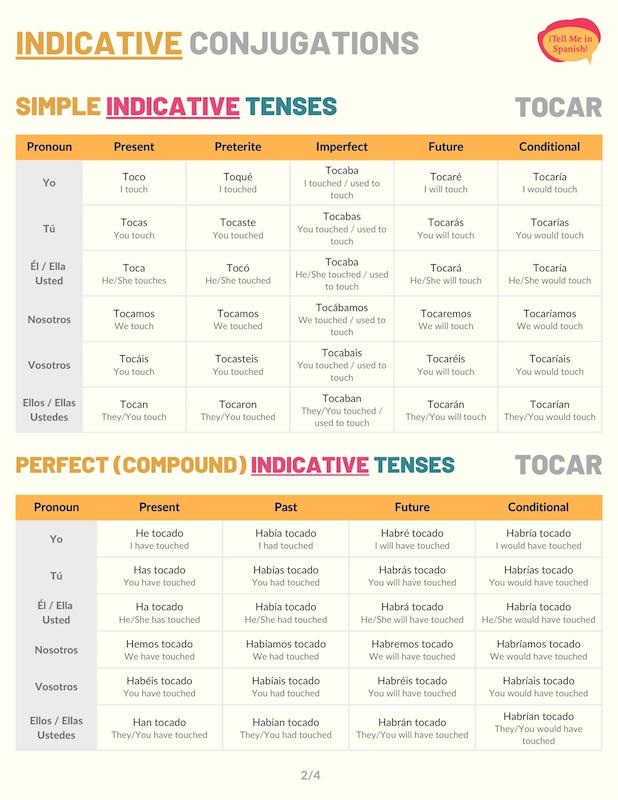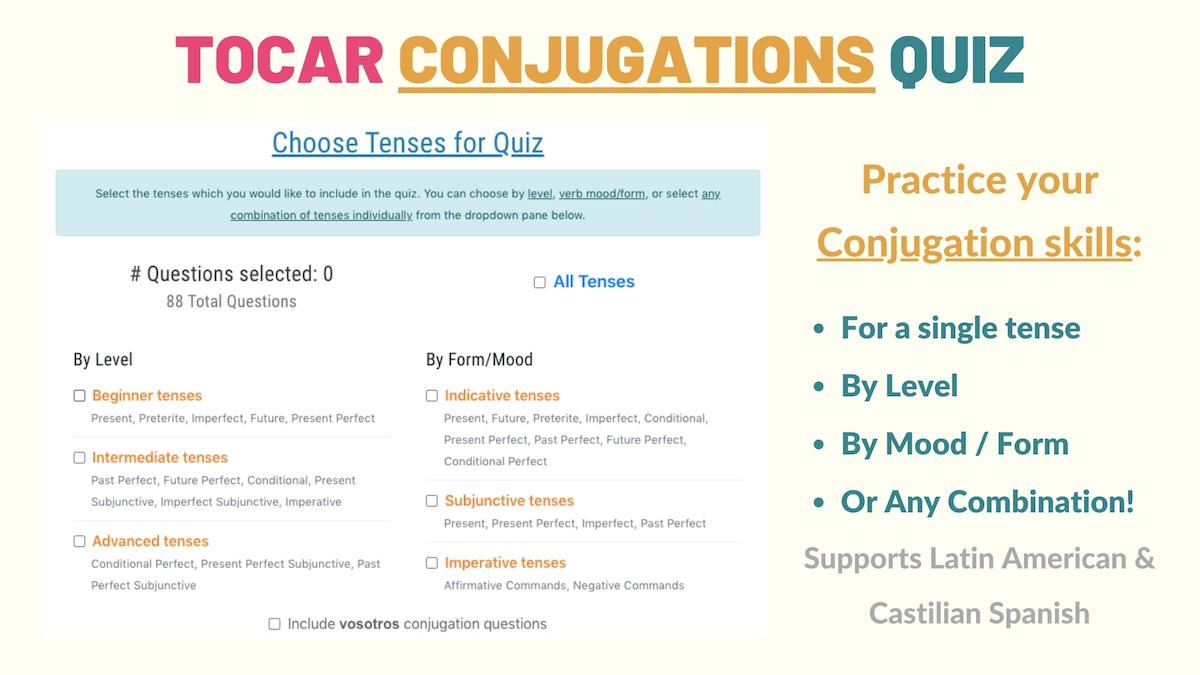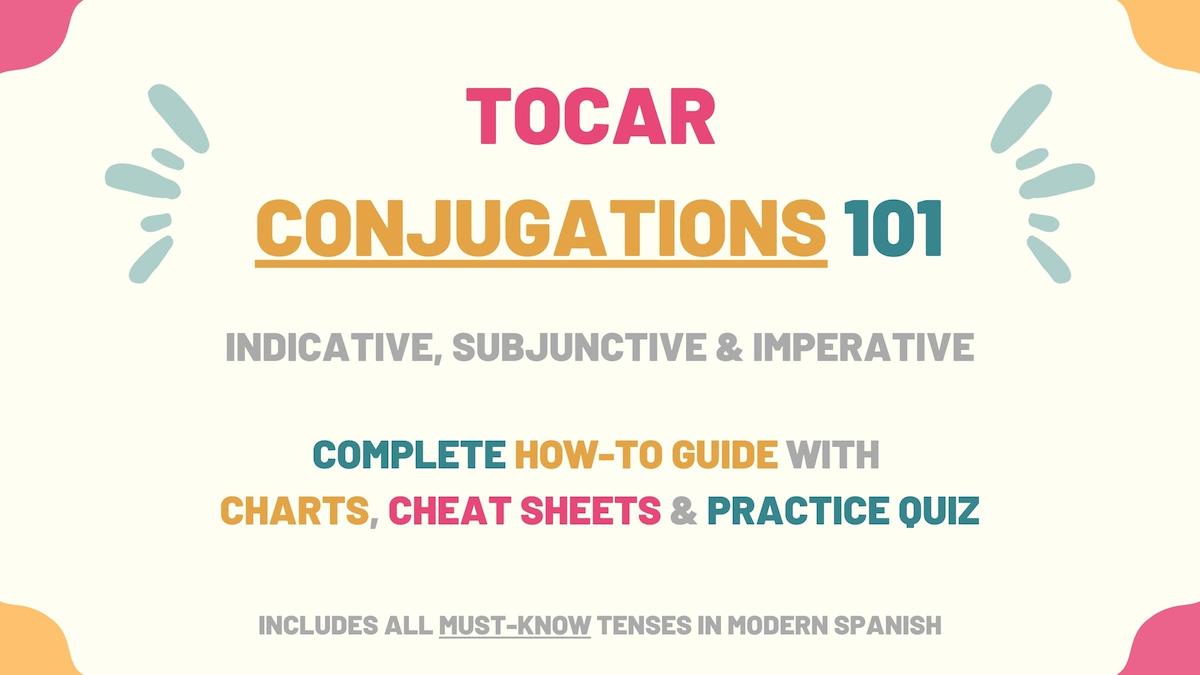Tocar is a common -AR verb with consonant changes in certain tenses. Since it can help you understand how verbs ending with –car work, in this guide, we’ll look at the most important tocar conjugation charts. Here’s what you’ll learn:
- Tocar Overview
- Indicative Tenses of Tocar Conjugations
- Subjunctive Tenses of Tocar Conjugations
- Imperative (Commands) of Tocar Conjugations
- Uses & Examples
- Download Tocar Conjugation Tables & Uses Cheat sheets
- Tocar Conjugation Practice Quiz
Overview of Tocar
| Verb Characteristic | Property |
|---|---|
| Verb Type | -AR |
| Irregular | No |
| Infinitive | Tocar |
| Gerund (Present Participle) Form | Tocando |
| Past Participle Form | Tocado |
| Synonyms | Concernir, palpar, ejecutar. |
Stem Changes: -CAR to -QU
- Present: toqu only for ‘yo’.
- Present subjunctive: toqu for all subject pronouns.
- Affirmative imperative: toqu only for ‘usted’ and ‘ustedes’.
- Negative imperative: toqu for all subject pronouns.
In Spanish, tocar means ‘to touch’, ‘to play’, ‘to knock’, ‘to get’, among other things. The tocar conjugation charts below only have one translation to keep them as organized as possible. You can check the section Uses & Meanings to learn more about the meanings of this verb.
Indicative Conjugations of Tocar
Present tense
In the Spanish present indicative tense, tocar is a regular verb. Use tocar’s present conjugations to communicate that someone touches something, knocks on a door, or plays an instrument. For example: Jesús toca la guitarra y el piano.
| Person | Conjugation | Translation |
|---|---|---|
| Yo | Toco | I touch |
| Tú | Tocas | You touch |
| Él / Ella Usted | Toca | He/She touches You (formal) touch |
| Nosotros | Tocamos | We touch |
| Vosotros | Tocáis | You touch |
| Ellos / Ellas Ustedes | Tocan | They touch You (plural) touch |
Preterite tense
Tocar preterite conjugations have a -CAR to -QU change only for the subject pronoun ‘yo’. Use this tense to explain that someone touched something or played an instrument at a specific time in the past. For example: Yo no toqué tus cosas.
| Person | Conjugation | Translation |
|---|---|---|
| Yo | Toqué | I touched |
| Tú | Tocaste | You touched |
| Él / Ella Usted | Tocó | He/She touched You (formal) touched |
| Nosotros | Tocamos | We touched |
| Vosotros | Tocasteis | You touched |
| Ellos / Ellas Ustedes | Tocaron | They touched You (plural) touched |
Take Note: All Spanish verbs that end with –car follow the same stem changes as tocar. These changes are made to keep pronunciation consistent.
Imperfect tense
When conjugated to the imperfect tense, tocar communicates that someone used to touch or play an instrument for an extended period of time in the past. For instance: Mi vecino tocaba en una banda de rock.
| Person | Conjugation | Translation |
|---|---|---|
| Yo | Tocaba | I touched I used to touch |
| Tú | Tocabas | You touched You used to touch |
| Él / Ella Usted | Tocaba | He/She touched He/She used to touch You (formal) touched You (formal) used to touch |
| Nosotros | Tocábamos | We touched We used to touch |
| Vosotros | Tocabais | You touched You used to touch |
| Ellos / Ellas Ustedes | Tocaban | They touched They used to touch You (plural) touched You (plural) used to touch |
Near future
Ir in present form + tocar is the formula to conjugate to the near future in Spanish. With this tense, tocar is used to say that a person will touch, knock on a door, or play an instrument soon in the future. Mañana, voy a tocar en ese bar.
| Person | Conjugation | Translation |
|---|---|---|
| Yo | Voy a tocar | I’m going to touch |
| Tú | Vas a tocar | You’re going to touch |
| Él / Ella Usted | Va a tocar | He/She is going to touch You (formal) are going to touch |
| Nosotros | Vamos a tocar | We’re going to touch |
| Vosotros | Vais a tocar | You’re going to touch |
| Ellos / Ellas Ustedes | Van a tocar | They’re going to touch You (plural) are going to touch |
Future simple tense
In the Spanish future simple tense, this verb conveys that someone will touch something or play an instrument at some moment in the future. For example: Tocaré la cafetera para ver si está fría.
| Person | Conjugation | Translation |
|---|---|---|
| Yo | Tocaré | I will touch |
| Tú | Tocarás | You will touch |
| Él / Ella Usted | Tocará | He/She will touch You (formal) will touch |
| Nosotros | Tocaremos | We will touch |
| Vosotros | Tocaréis | You (formal) will touch |
| Ellos / Ellas Ustedes | Tocarán | They will touch You (plural) will touch |
Conditional tense
The conditional conjugations of tocar allow you to express that someone would touch a person or object or play an instrument. For example: ¿Me tocarías mi canción favorita?
| Person | Conjugation | Translation |
|---|---|---|
| Yo | Tocaría | I would touch |
| Tú | Tocarías | You would touch |
| Él / Ella Usted | Tocaría | He/She would touch You (formal) would touch |
| Nosotros | Tocaríamos | We would touch |
| Vosotros | Tocaríais | You would touch |
| Ellos / Ellas Ustedes | Tocarían | They would touch You (plural) would touch |
Present perfect tense
The present perfect tense in Spanish is formed with haber in the present tense + tocado (past participle verb). Use these tocar conjugations to discuss what people have or haven’t touched. For instance: Niños, ¿quién ha tocado esta pared?
| Person | Conjugation | Translation |
|---|---|---|
| Yo | He tocado | I have touched |
| Tú | Has tocado | You have touched |
| Él / Ella Usted | Ha tocado | He/She has touched You (formal) have touched |
| Nosotros | Hemos tocado | We have touched |
| Vosotros | Habéis tocado | You have touched |
| Ellos / Ellas Ustedes | Han tocado | They have touched You (plural) have touched |
Past perfect
In the Spanish past perfect indicative tense, tocar is used to express that someone had or hadn’t touched something or played an instrument before another past action or point in time. For instance: Nunca habíamos tocado una tela tan suave.
The formula to the past perfect tense is haber (imperfect form) + past participle form of ‘tocar’.
| Person | Conjugation | Translation |
|---|---|---|
| Yo | Había tocado | I had touched |
| Tú | Habías tocado | You had touched |
| Él / Ella Usted | Había tocado | He/She had touched You (formal) had touched |
| Nosotros | Habíamos tocado | We had touched |
| Vosotros | Habíais tocado | You had touched |
| Ellos / Ellas Ustedes | Habían tocado | They had touched You (plural) had touched |
Future perfect
Conjugate tocar to the Spanish future perfect tense to express that people will have touched something or played an instrument by or before a certain future time frame. These conjugations are also used to talk about what someone might have touched. ¿Quién habrá tocado mi pintura?
| Person | Conjugation | Translation |
|---|---|---|
| Yo | Habré tocado | I will have touched |
| Tú | Habrás tocado | You will have touched |
| Él / Ella Usted | Habrá tocado | He/She will have touched You (formal) will have touched |
| Nosotros | Habremos tocado | We will have touched |
| Vosotros | Habréis tocado | You will have touched |
| Ellos / Ellas Ustedes | Habrán tocado | They will have touched You (plural) will have touched |
Conditional perfect
Tocar conjugated to the Spanish conditional perfect tense, conveys that someone would have touched something or played an instrument as long as a past condition had taken place. For instance: Si hubieras puesto un letrero, nadie habría tocado los cuadros.
| Person | Conjugation | Translation |
|---|---|---|
| Yo | Habría tocado | I would have touched |
| Tú | Habrías tocado | You would have touched |
| Él / Ella Usted | Habría tocado | He/She would have touched You (formal) would have touched |
| Nosotros | Habríamos tocado | We would have touched |
| Vosotros | Habríais tocado | You would have touched |
| Ellos / Ellas Ustedes | Habrían tocado | They would have touched You (plural) would have touched |
Progressive tenses
The progressive tenses in Spanish are formed with estar conjugations + present participle (tocando, for this example). With progressive tenses, this verb expresses that someone was touching something or playing an instrument at the moment of speaking or when a past action took place.
For example: Cuando entré, los niños estaban tocando el piano.
| Progressive Tense | Formula | Translation Example |
|---|---|---|
| Present | Estar (present) + tocando | I am touching |
| Preterite | Estar (preterite) + tocando | You were touching |
| Imperfect | Estar (imperfect) + tocando | He was touching |
| Future | Estar (future) + tocando | We will be touching |
| Conditional | Estar (conditional) + tocando | They would be touching |
Tocar Subjunctive Conjugations
In Spanish, the subjunctive tenses allow you to refer to hopes, demands, suggestions, expectations, doubts, or hypothetical situations. In the sections below, you’ll find the tocar conjugation charts for the most important subjunctive tenses you must know.
Present subjunctive
Tocar subjunctive conjugations have a -CAR to QU change to keep pronunciation consistent. You can see how these changes work in the conjugation chart below. Use tocar’s subjunctive forms to wish or request that someone touches something or plays an instrument.
For example: Quiero que nos toques esta canción.
| Person | Conjugation | Translation |
|---|---|---|
| Yo | Toque | I touch |
| Tú | Toques | You touch |
| Él / Ella Usted | Toque | He/She touches You (formal) touch |
| Nosotros | Toquemos | We touch |
| Vosotros | Toquéis | You touch |
| Ellos / Ellas Ustedes | Toquen | They touch You (plural) touch |
Present perfect subjunctive
To conjugate this verb to the present perfect subjunctive, use haber (present subjunctive) + tocado (Spanish past participle form). These conjugations are used to express doubt, wish, or wonder if someone has already touched something or played an instrument.
For instance: ¿Quién crees que haya tocado mis pinturas?
| Person | Conjugation | Translation |
|---|---|---|
| Yo | Haya tocado | I have touched |
| Tú | Hayas tocado | You have touched |
| Él / Ella Usted | Haya tocado | He/She has touched You (formal) have touched |
| Nosotros | Hayamos tocado | We have touched |
| Vosotros | Hayáis tocado | You have touched |
| Ellos / Ellas Ustedes | Hayan tocado | They have touched You (plural) have touched |
Imperfect subjunctive
In Spanish, the imperfect subjunctive tense conveys past suggestions, requests, and wishes someone had about a person playing an instrument or touching something. Te pedí que no tocaras mis cosas.
The imperfect subjunctive tense has two conjugation models depending on whether you’re speaking Latin American or Castilian Spanish:
Latin American Spanish version
| Person | Conjugation | Translation |
|---|---|---|
| Yo | Tocara | I touched |
| Tú | Tocaras | You touched |
| Él / Ella Usted | Tocara | He/She touched You (formal) touched |
| Nosotros | Tocáramos | We touched |
| Ellos / Ellas Ustedes | Tocaran | They touched You (plural) touched |
Note: Because vosotros’ conjugation is not used in Latin American Spanish, this pronoun and its conjugation have not been included in the previous tocar conjugation chart.
Castilian Spanish version
| Person | Conjugation | Translation |
|---|---|---|
| Yo | Tocase | I touched |
| Tú | Tocases | You touched |
| Él / Ella Usted | Tocase | He/She touched You (formal) touched |
| Nosotros | Tocásemos | We touched |
| Vosotros | Tocaseis | You touched |
| Ellos / Ellas Ustedes | Tocasen | They touched You (plural) touched |
Past perfect subjunctive
In the Spanish past perfect subjunctive, this verb conveys that someone would have touched something or played an instrument if a past condition had occurred. These subjunctive forms also express regret for touching or not touching something.
For example: Si no lo hubieras tocado, no se hubiera caído.
| Person | Conjugation | Translation |
|---|---|---|
| Yo | Hubiera tocado | I had touched |
| Tú | Hubieras tocado | You had touched |
| Él / Ella Usted | Hubiera tocado | He/She had touched You (formal) had touched |
| Nosotros | Hubiéramos tocado | We had touched |
| Vosotros | Hubierais tocado | You had touched |
| Ellos / Ellas Ustedes | Hubieran tocado | They had touched You (plural) had touched |
Tocar Imperative Conjugations
Commands in Spanish are used to give orders to people on what to do or not do.
Affirmative commands
The affirmative commands of tocar have a -CAR to -QU change only for ‘usted’ and ‘ustedes’. Use these imperative forms to command people to touch something or play an instrument. For instance: Por favor, toque este botón.
| Person | Conjugation | Translation |
|---|---|---|
| Tú | Toca | Touch |
| Usted | Toque | Touch |
| Vosotros | Tocad | Touch |
| Ustedes | Toquen | Touch |
Negative commands
On the other hand, if you want to order someone not to touch something or play an instrument, you must conjugate tocar to the Spanish negative imperative. ¡No toquen la estufa! As shown in the conjugation chart below, these conjugations of tocar also have a stem change.
| Person | Conjugation | Translation |
|---|---|---|
| Tú | No toques | Don’t touch |
| Usted | No toque | Don’t touch |
| Vosotros | No toquéis | Don’t touch |
| Ustedes | No toquen | Don’t touch |
Meanings of Tocar & Examples
Given that you’re already familiar with how to conjugate tocar in Spanish, let’s see the contexts where you can apply this verb. Depending on the sentence, tocar means to:
- Touch, knock (on a door), or honk
- Play (only for music or instruments)
- Touch on or mention (a subject)
- Be someone’s turn
- Be entitled to or get
Here some examples:
[Tocar conjugated] + [complement]
¿A quién le toca cambiar al bebé?
Whose turn is it to change the baby?
No quiero que toquen ese tema otra vez.
I don’t want you to mention that subject again.
La banda de mi hermano tocaba en ese café.
The brother’s band played in that coffee shop.
Take Note: The verb jugar also means to ‘play’. However, when referring to music or instruments, you must always use ‘tocar’.
Download Tocar Conjugation Tables & Uses Cheat sheets

Tocar is a very common regular verb with many meanings and uses in Spanish. So, I’ve created a PDF you can download containing all the tocar conjugation charts along with its meanings, uses, and real-world examples so you can see how to apply it in your conversations.
Practice Quiz: Tocar Conjugation

Now that you know how to conjugate tocar, you can take the tocar conjugation practice quiz to drill yourself on regular -AR verb forms.



